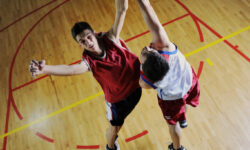Have you ever wondered what it takes to become an Olympian. I guess the first thing is to have some talent in your chosen sport but, as Olympic Champion Mo Farah says, “You don’t have to be the best to win a gold medal, sometimes you just have to want it more than the next guy.”
That said, there are some sports where a certain body type or a special ability will put you ahead of the field. Helen Glover was chosen by British Rowing to train to be a rower during a nationwide search for potential talent. She had never rowed before but she was chosen because she was very tall. That she took her opportunity and is now an Olympic Champion is down to her mindset, but her genes gave her one step up the ladder. Likewise, Olympian gymnast Max Whitlock’s amazing ability on the pommel horse and parallel bars are astonishing to watch, but if he had been tall and skinny, his gymnastics career would have faltered early.
Nature or nurture?
For many sports, particularly the team sports such as hockey, rugby and football, body shape does not play such a large part, but the qualities of endurance, speed and agility are very important factors. To a point you can train for these elements of fitness but some people are just born with more fast twitch fibres than others.
Jessica Ennis-Hill and other multi-disciplinary athletes are probably the best examples of athletes who were given a certain level of ability and then psychological desire to win takes over in the ones that make it to the top. Through her career, Jess has had to work hard on all her seven disciplines but for javelin and high jump, she has had to work incredibly hard as these were two areas in which she was weakest.
Get a life… or be an Olympian
Whatever the sport, whatever the level of natural ability, there is no doubting the amount of effort that the athletes put in. They are commonly quoted as saying their lives go on hold while they train for an Olympics. Social life, family life, just letting your hair down – it doesn’t really happen during that four-year build up to the Games. Long jumper Greg Rutherford says that he has missed some of the most important stages of his baby’s early months because of his sport; Jessica Ennis-Hill fits in a training session between present-opening on Christmas morning and Christmas dinner; Bradley Wiggins gets on his bike no matter what the Cumbrian skies are throwing at him. It might be a moment of glory as they stand on the podium, but our Olympians have gone through years of graft to get there.

To give you some idea of what it takes to make it to the start line of the Rio Olympics, here is a typical week from the training diary of the double Olympian and reigning 5,000m and 10,000m Champion Mo Farah.
Monday
AM: 10-mile recovery run (6:00min/mile pace)
PM: 6-mile recovery run
Tuesday
AM: 4-mile warm-up run; 8-12mile tempo run anywhere from 4:40 to 5:00min/mile pace (depending on altitude and terrain); 3-mile cool-down run
NOON: Strength and conditioning session (1 hour)
PM: 6-mile recovery run
Wednesday
AM: 12-mile recovery run, followed by a massage.
PM: 5-mile recovery run
Thursday
AM: 11-mile recovery run
PM: 5-mile recovery run
Friday
AM: 4-mile warm-up jog; 10x200m intervals (with 200m recovery jogs) on grass in 29 seconds each rep; 10x200m hill sprints at equal effort, walk back down to recover; 4-mile cool-down run.
NOON: Strength and conditioning session (1 hour)
PM: 4-miles easy
Saturday
AM: 11-mile recovery run, massage
PM: 6-mile recovery run
Sunday
AM: 22-27 miles, no slower than marathon race pace + 1 minute (for Mo, this means 5:40min/mile)
Anyone interested in taking up a new sport should visit the BBC Get Inspired website or have a chat with one of the staff at Kelsey Kerridge Sports Centre who can point you in the right direction.







